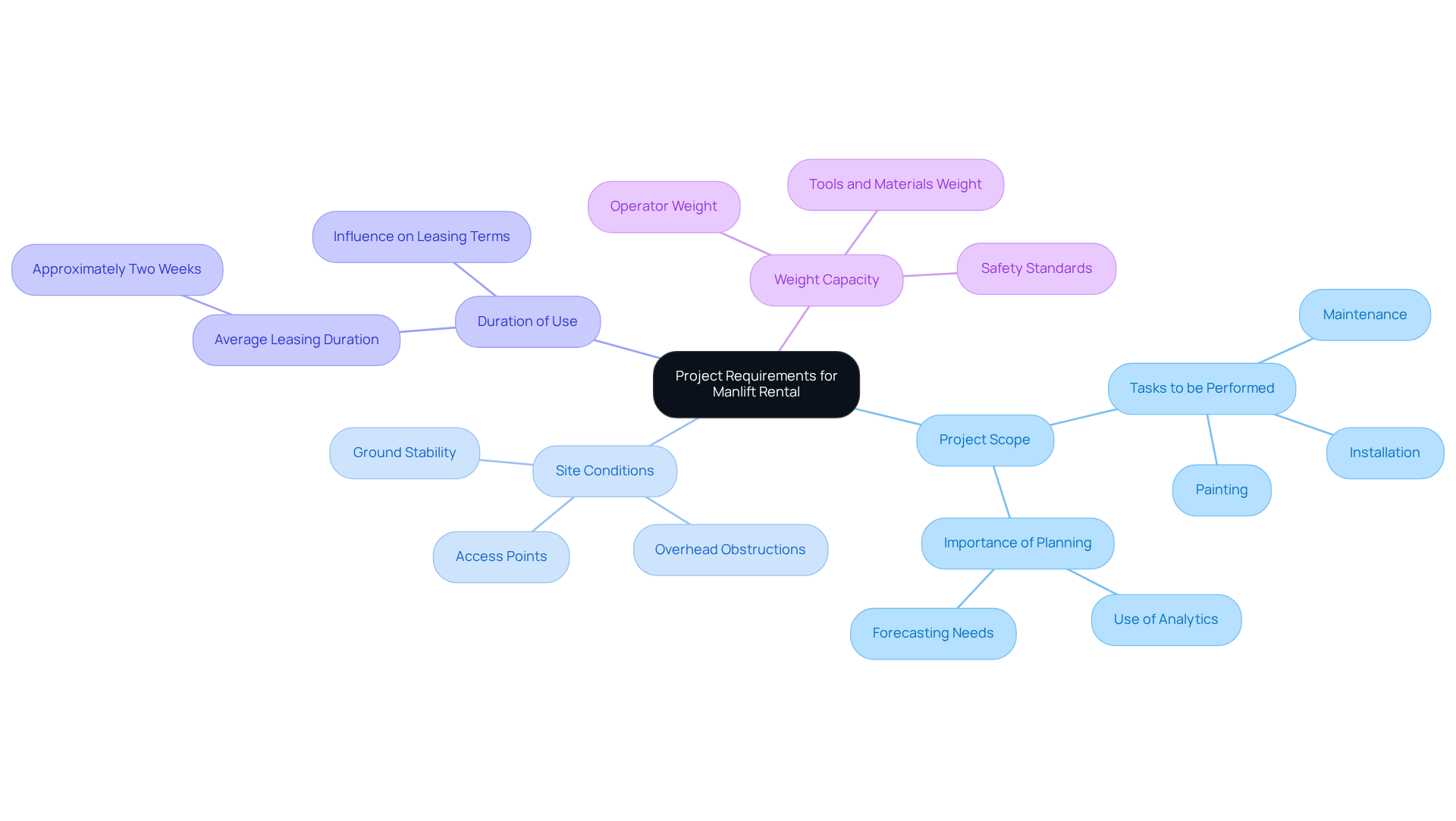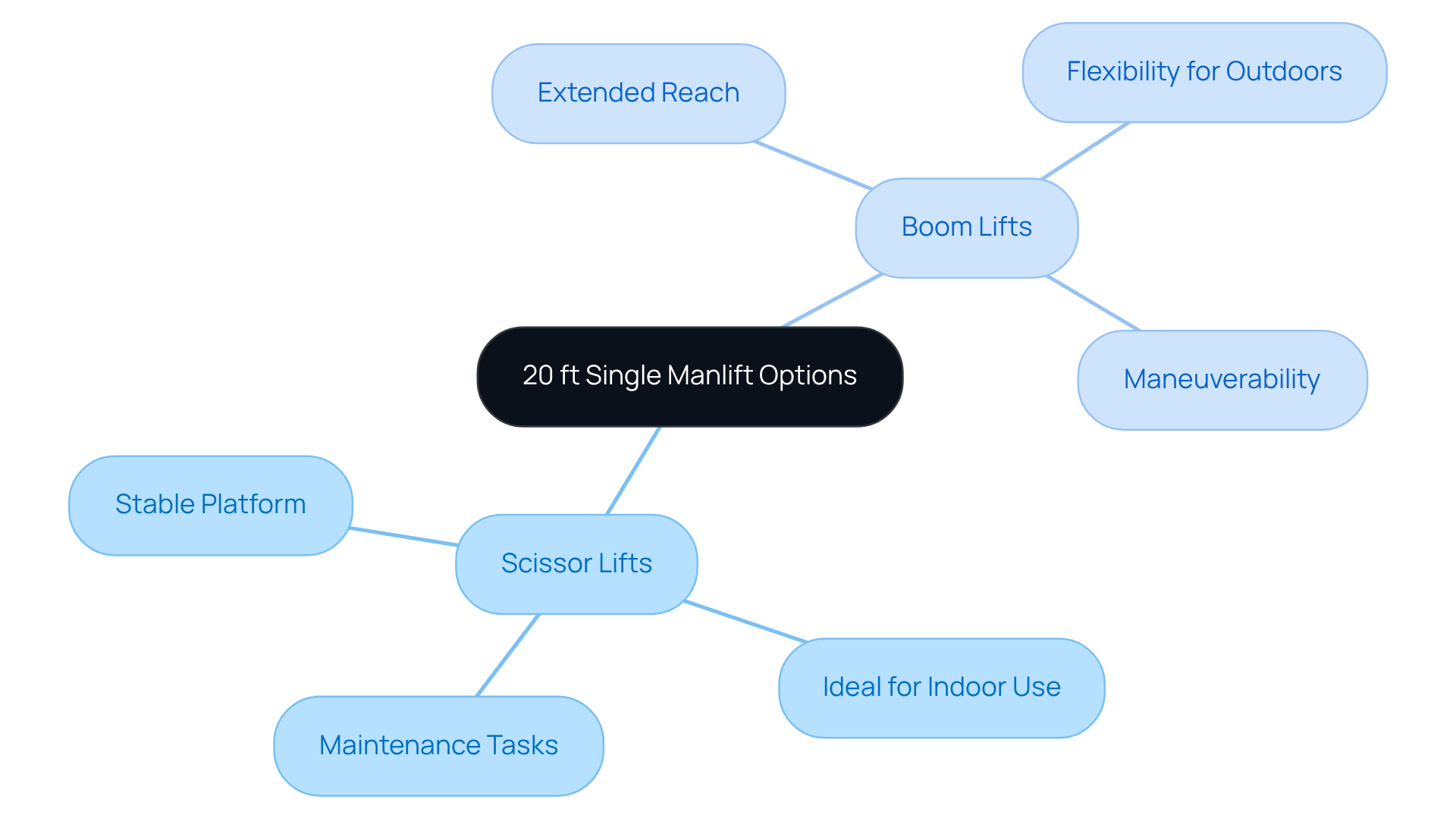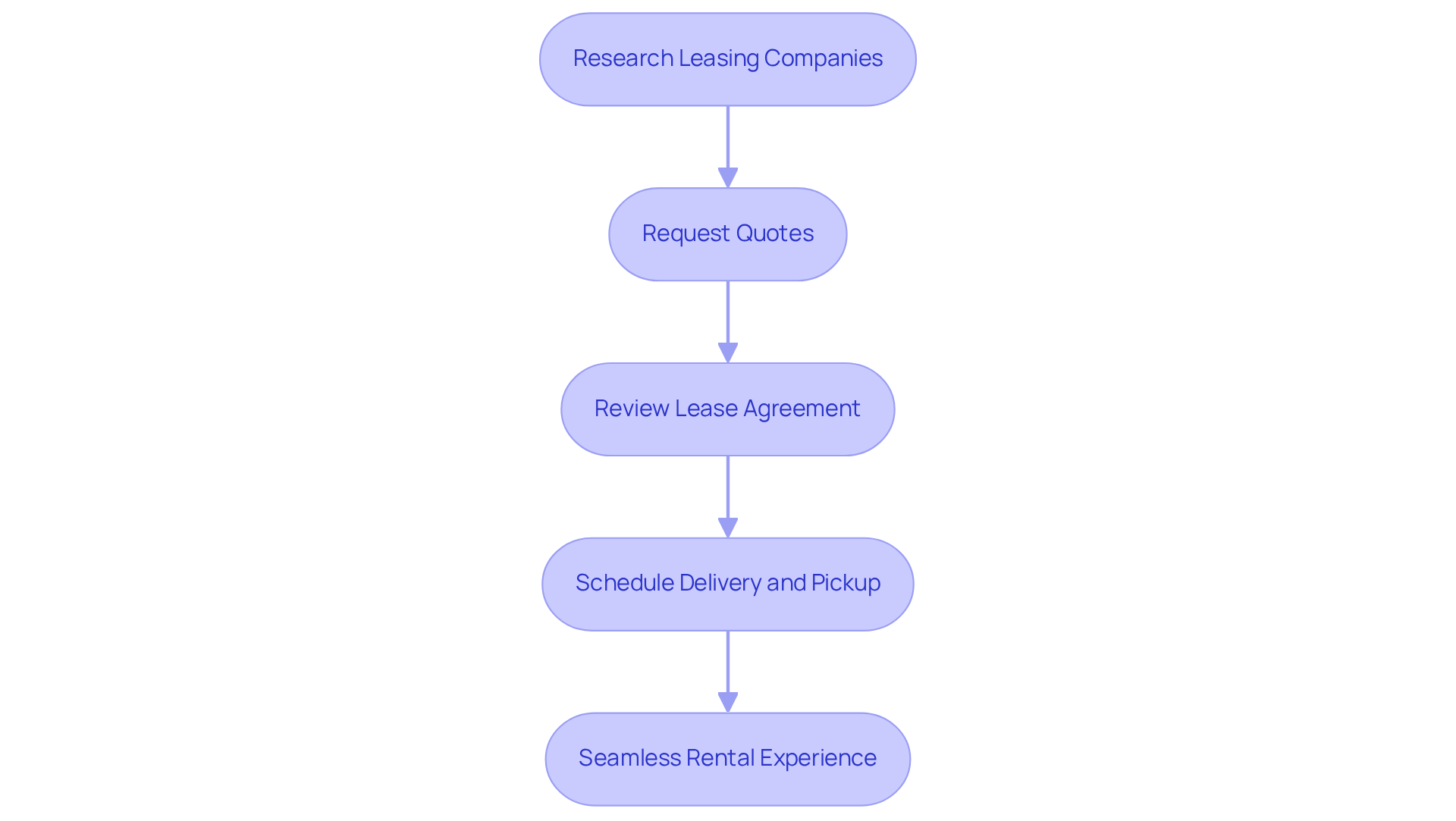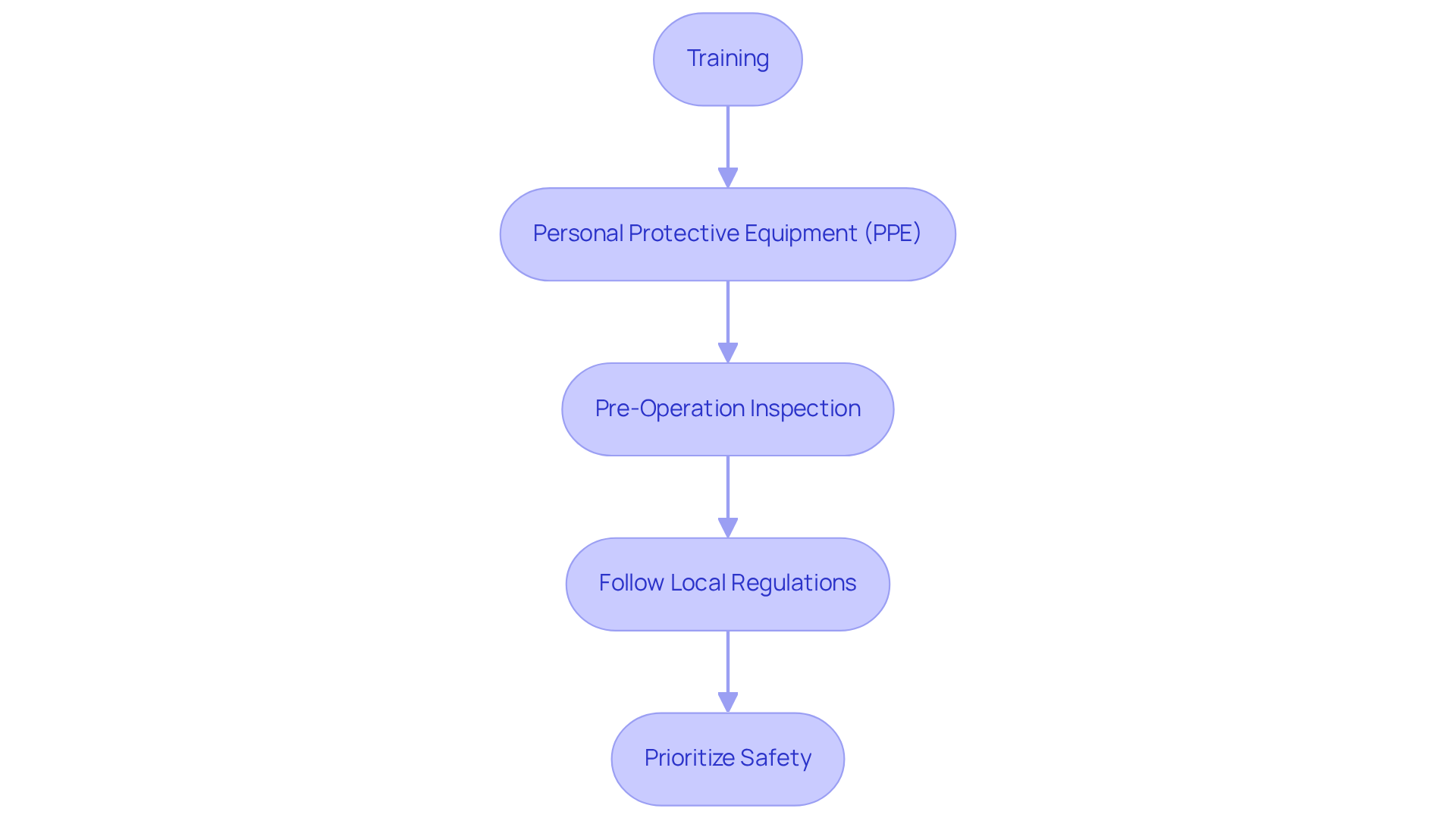Overview
This article outlines four essential steps for successfully renting a 20 ft single manlift.
- Evaluate your project requirements to ensure the lift meets your specific needs.
- Choose the appropriate lift type based on those requirements, considering factors such as weight capacity and reach.
- Navigate the rental process, which includes comparing leasing options and understanding the terms of the rental agreement.
- Ensure safety compliance by adhering to OSHA standards, which are crucial for maintaining operational safety on-site.
In addition to these steps, detailed considerations play a critical role in streamlining the rental experience.
- Assessing site conditions is vital; it helps in determining the best lift type for your environment.
- Comparing leasing options can lead to better pricing and availability, ensuring that you secure the best deal for your project.
- By adhering to OSHA standards, not only do you comply with regulations, but you also enhance the safety of your operations, protecting both your team and your investment.
Collectively, these steps and considerations help enhance operational safety while simplifying the rental process. By following this guide, you can confidently navigate the complexities of renting a manlift, ensuring that your project runs smoothly and efficiently. Take action now—evaluate your needs and start the rental process today for a safer, more productive work environment.
Key Highlights:
- Evaluate project requirements including scope, site conditions, duration of use, and weight capacity before renting a manlift.
- Scissor lifts are suitable for indoor tasks requiring vertical lifting, while boom lifts are ideal for outdoor tasks and uneven terrain.
- Research leasing companies and compare quotes, terms, and additional fees to find the best rental option.
- Thoroughly review the lease agreement focusing on insurance, liability, and maintenance responsibilities.
- Ensure all operators are trained and certified, and utilise personal protective equipment (PPE) for safety.
- Conduct pre-operation inspections of the manlift and adhere to local regulations and OSHA standards for compliance.
Introduction
Navigating the world of equipment rentals can often feel overwhelming, particularly when dealing with specialized machinery such as a 20 ft single manlift. It is crucial to understand the intricacies of project requirements, select the appropriate type of lift, and ensure compliance with safety standards. These essential steps significantly impact the success of any job. With numerous options and regulations to consider, how can one guarantee a seamless rental experience? This guide delineates the essential steps for a successful manlift rental, empowering readers to make informed decisions that enhance productivity and safety in their projects.
Understand Your Project Requirements
Before considering a 20 ft single manlift rental, it is essential to evaluate your task's specific needs with precision. Consider the following critical factors:
- Project Scope: Clearly define the tasks to be performed with the manlift, such as painting, maintenance, or installation. Understanding the project scope is vital for selecting the right equipment for the job. As Josh Nickell, Vice President of the American Rental Association, emphasizes, "You can’t just assume that there’s a piece of equipment on your lot or hope one will be back in time; you have got to do a lot more planning, and use analytics to forecast what your needs are going to be."
- Site Conditions: Evaluate the work environment meticulously, including ground stability, overhead obstructions, and access points. This assessment is essential to determine if a lift is appropriate for your location and to guarantee safe operation.
- Duration of Use: Estimate the length of time you will require the manlift. The average leasing duration for construction equipment is generally about two weeks, a factor that can significantly influence leasing terms and overall expenses. This statistic underscores the importance of effective planning for your rental period.
- Weight Capacity: Ensure that the manlift can safely accommodate the combined weight of the operator and any tools or materials required for the task. This consideration is crucial for maintaining safety standards on-site.
By clearly defining these requirements, you can streamline the selection process for a 20 ft single manlift rental and ensure that this rented equipment aligns perfectly with your needs, ultimately contributing to successful execution.

Choose the Right Type of 20 ft Single Manlift
To effectively fulfill your assignment needs, choosing the appropriate 20 ft single manlift rental is essential. Consider the following key options:
- Scissor Lifts excel in vertical lifting, offering a stable platform that is ideal for tasks requiring height. They are particularly suited for indoor applications or flat surfaces, making them a preferred choice for maintenance and repair work in confined spaces.
- Boom Lifts, on the other hand, provide extended reach and flexibility, designed specifically to access hard-to-reach areas. This makes them ideal for outdoor tasks and uneven terrain. Their ability to maneuver around obstacles significantly enhances their utility in construction tasks, such as electrical installations and HVAC work.
When choosing a lift, it is crucial to consider both weight and size. Ensure that the lift can safely accommodate the operator's weight along with any tools or materials. Additionally, verifying the dimensions is critical to confirm that the lift fits within your workspace constraints.
By thoughtfully selecting the appropriate type of lift, you can significantly enhance productivity while upholding safety standards throughout your project. Take action now to ensure you have the right equipment for your needs.

Navigate the Rental Process Effectively
To effectively navigate the rental process for a 20 ft single manlift, follow these essential steps:
- Research Leasing Companies: Begin by identifying reputable equipment leasing firms in your area, such as EZ Equipment Rental, known for its unwavering commitment to quality and reliability. Their meticulously maintained forklifts undergo regular inspections and servicing, ensuring optimal performance and safety.
- Request Quotes: Reach out to multiple leasing firms to gather quotes. It is crucial to compare not only prices but also leasing terms, availability, and any additional fees that may apply, such as charges for late returns, damages, cleaning, and cancellations.
- Review Lease Agreement: Carefully scrutinize the lease agreement. Pay special attention to clauses related to insurance, liability, and maintenance responsibilities to ensure a thorough understanding of your obligations. Clarity in the contract regarding how much of the rent applies to the purchase price is vital if you are considering a Rental Purchase Option.
- Schedule Delivery and Pickup: Coordinate with the leasing company to arrange the delivery of the manlift to your work site and schedule pickup once your task is completed. Always conduct routine checks before operating the machinery to ensure security and reliability.
By adhering to these steps, you can facilitate a seamless 20 ft single manlift rental experience with EZ Equipment Rental, minimizing the risk of unexpected issues and ensuring that your project proceeds smoothly.

Ensure Safety and Compliance Standards
Before operating a 20 ft single manlift rental, it is crucial to adhere to all safety and compliance standards.
- Training: All operators must be properly trained and certified to use the manlift. This training should encompass a thorough understanding of the controls, protective features, and emergency procedures. OSHA mandates that only qualified and authorized individuals operate aerial lifts, emphasizing that 'Aerial lift training isn’t a 'one and done' matter, either.' This underscores the necessity for continuous instruction to tackle any new risks or equipment categories.
- Personal Protective Equipment (PPE): Operators should be equipped with essential PPE, including hard hats, harnesses, and protective footwear. The use of PPE significantly reduces the risk of injury, particularly in environments where falling objects or equipment malfunctions may occur. As highlighted by trainers, 'proper PPE is a fundamental aspect of operational security,' reinforcing the necessity of these protective measures.
- Pre-Operation Inspection: Conducting a thorough inspection of the manlift before use is vital. This inspection should address mechanical components and protective features to identify any potential hazards. Regular maintenance, as recommended by ANSI standards, suggests frequent inspections every three months or 150 hours to ensure that the equipment remains in optimal working condition and minimizes the risk of accidents.
- Follow Local Regulations: Familiarize yourself with Texas regulations regarding equipment operation, including understanding the weight limits of aerial lifts, which is essential for protection. Compliance with these regulations is crucial to avoid fines and legal issues. OSHA regulations provide a framework for safe operation, while ANSI standards offer additional guidelines that, although voluntary, are often incorporated into legal requirements.
By prioritizing safety and compliance, you can protect your team and ensure a successful project outcome.

Conclusion
Understanding the nuances of renting a 20 ft single manlift is essential for ensuring project success. By thoroughly assessing project requirements, selecting the right type of lift, navigating the rental process effectively, and prioritizing safety, individuals can streamline their operations and achieve desired outcomes with confidence.
Key considerations include:
- Defining the project scope
- Evaluating site conditions
- Estimating the duration of use
These factors contribute significantly to making informed decisions. Furthermore, choosing between scissor lifts and boom lifts based on specific project needs can enhance efficiency. A well-executed rental process—encompassing thorough research of rental companies and careful review of lease agreements—further mitigates risks associated with equipment rental.
Ultimately, prioritizing safety and compliance is not just a regulatory obligation; it is a fundamental aspect of operational success. Ensuring that all operators are trained, equipped with proper PPE, and familiar with local regulations significantly diminishes the likelihood of accidents. Emphasizing these practices not only protects the workforce but also enhances the overall effectiveness of the project. By taking these steps, you ensure that the rental experience is not only successful but also safe and compliant, paving the way for smooth project execution.
Frequently Asked Questions
What should I consider before renting a 20 ft single manlift?
Before renting a 20 ft single manlift, you should evaluate your project's specific requirements, including the project scope, site conditions, duration of use, and weight capacity.
How do I define the project scope?
The project scope involves clearly defining the tasks to be performed with the manlift, such as painting, maintenance, or installation. This understanding is crucial for selecting the right equipment for your needs.
Why are site conditions important when renting a manlift?
Site conditions are important because they include factors like ground stability, overhead obstructions, and access points, which determine if a lift is suitable for your location and ensure safe operation.
How long should I plan to use the manlift?
You should estimate the length of time you will need the manlift. The average leasing duration for construction equipment is typically about two weeks, which can affect leasing terms and overall costs.
What is the significance of weight capacity when renting a manlift?
It is crucial to ensure that the manlift can safely accommodate the combined weight of the operator and any tools or materials required for the task, as this is essential for maintaining safety standards on-site.
How can I ensure that the rented equipment aligns with my needs?
By clearly defining your project requirements, including project scope, site conditions, duration of use, and weight capacity, you can streamline the selection process for a manlift rental and ensure it meets your needs effectively.




